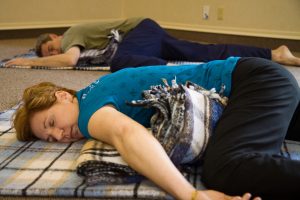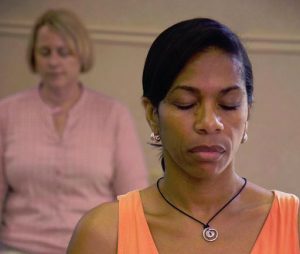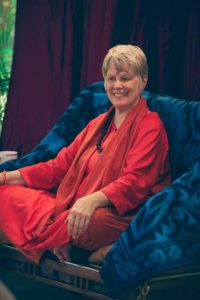When you decide how much yoga you are going to do, you are deciding two things:
(1) what to do with some available time (a simple thing), and
(2) what your goal in life is (a really big deal!).
You are really choosing —do you want to be happy or do you want to be bliss-full? These are very different things. The beginning of a new year is the perfect time to consider why you do the things that you do — are you using yoga to help you pursue success, to improve yourself or to delve into consciousness?
In the name of success, you try to manage the people and things in your life, or you try to acquire more of both. If you are able to manage everything, then you can finally be happy. But you run into a few hurdles. Happiness through attaining success is possible, but just barely. Along the way, it is very stressful. You can do yoga just to recover from the strain; it balances out the rest of your life. In this case, attending a yoga class once or twice per week will be enough, or your home practice makes you better able to handle everything again the next day.
The Yoga Vasishtha says that a wise person is one who learns from the experiences of others without having to repeat them personally. If you look around you, you will see that those pursuing success are not happy. Whether they are pursuing success in things or in relationships, their experience of happiness comes and goes. It never lasts because something always needs fixing. You can learn from their life, a form of wisdom.
A wise person knows that happiness actually comes from an inner change, not from managing outer events. As you open the tensions in your spine, your whole sense of self opens up — this is called transformation. Your reactions to external events become different; you take things in stride more easily. You see your life more clearly and to make decisions based on your newfound inner clarity. The people and things in your life benefit from your inner transformation as you use yoga as the catalyst to personal transformation. If you are doing yoga for personal transformation, then you need to do more yoga.
Patanjali explains this in a sutra:
mrdu-madhy-aadhimaatratvaat tato’pi visheshah. —Yoga Sutras 1.22
Your rate of progress depends on how much practice you do: mild, medium or intense. [rendered by Swami Nirmalananda]
 Mild practice is described above: to balance out the stress that comes from your pursuit of the perfect life. Your weekly yoga class or 20-minute daily practice clears tensions from your muscles and stress hormones from your blood, so you can go back to the endeavors that will create success in the significant parts of your life.
Mild practice is described above: to balance out the stress that comes from your pursuit of the perfect life. Your weekly yoga class or 20-minute daily practice clears tensions from your muscles and stress hormones from your blood, so you can go back to the endeavors that will create success in the significant parts of your life.
To live in the inner peace that arises from doing yoga, you need to do more — a medium amount. You need at least 45 minutes per day, and to include meditation in your practice. The inner world is fluid: you are either progressing into more openness or you are backsliding into fixity. You cannot maintain — you must progress. For this, you need a medium amount of practice.
Using yoga in this way, to create personal transformation, is a beautiful and powerful practice. Yet yoga offers you much more. Yoga is specifically for the purpose of transcending your idea of who you are, not merely transforming it. You know this from the best Shavasana, or from even a few moments of sitting perfectly still in a seated pose or after a twist. The vastness of your own inner essence becomes undeniable.
Each time that you do Svaroopa® yoga, the spinal decompression creates an opening to the innermost dimensions of your own existence. To take advantage of this opening, you need to take some time to delve inward more deeply so your inner experience leaves an imprint on your mind. This is especially true in meditation. Each time your mind is imprinted by the Self, it becomes less of an obstacle and more and more clear — so you can see through it to the Self. Now you’re using yoga for its original purpose — for the inner discovery of your own Divinity, and for living in this expansive inner Beingness all the time.
If this is your goal, you need to do even more yoga. If the inner experience is the most significant thing in your life, then meditation becomes the cornerstone of your daily practice. The opening of your spine opens you into meditation, and the poses also prepare your body to hold the richness of that inner experience. Your body must be transformed in order to be the vehicle of the Self — the means by which that joy and love is expressed into the world.
 Your entire life becomes the conduit of consciousness, but only if you want it to. For this goal, one hour daily can be your basic practice, with a few days each week where you allow yourself the indulgence of more time — up to three hours, but not more. Your maximum is three hours per day. As long as you have your work and your relationships, this maximum will work well for you.
Your entire life becomes the conduit of consciousness, but only if you want it to. For this goal, one hour daily can be your basic practice, with a few days each week where you allow yourself the indulgence of more time — up to three hours, but not more. Your maximum is three hours per day. As long as you have your work and your relationships, this maximum will work well for you.
At this point, some of you are thinking that three hours of yoga and meditation a day is pure craziness — and others are thinking that anyone who tries to get by on 20 minutes per day is crazy. Please read through all of this again; the important part is not the amount of time. The important part is your goal.
If you want success most of all, then you should not do three hours of yoga a day — you will be supported in achieving success by doing 20 minutes per day. This is a good choice for you. If you want transformation, or if you want to know consciousness, then 20 minutes won’t do it. You have to make a different choice.
You do decide, every day, how much yoga you will do and what your goal is. Even if you decide to not decide, you have made a choice. It’s time to make a choice, even to make a resolution — a New Year’s resolution. For my choice – I always say, “Do more yoga!”
